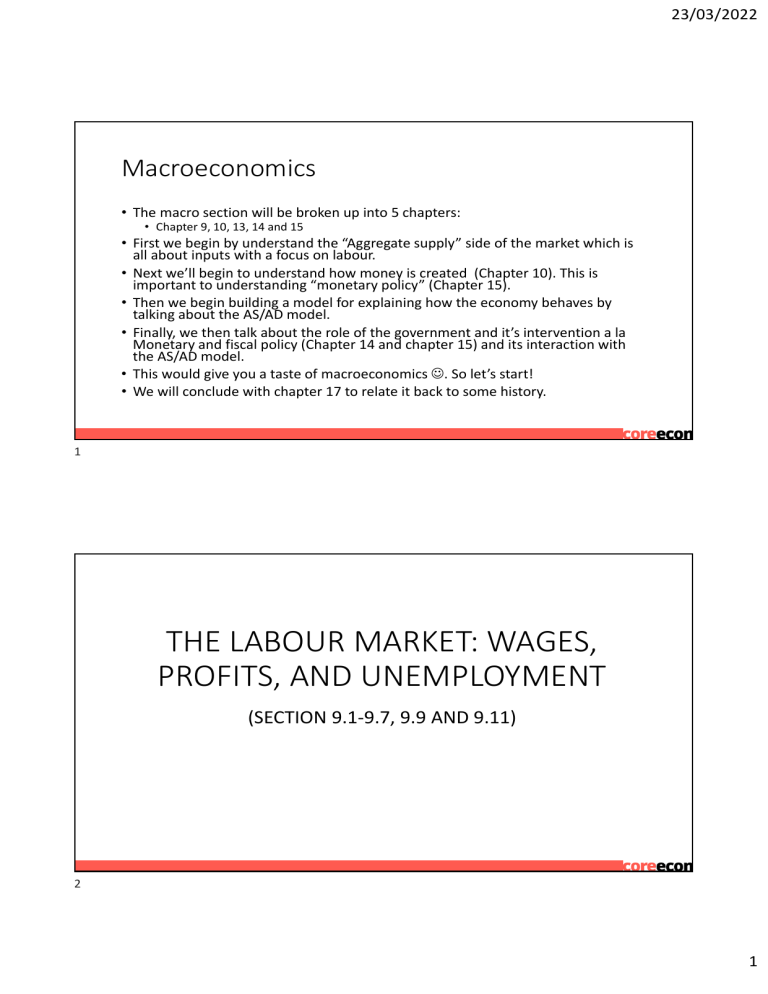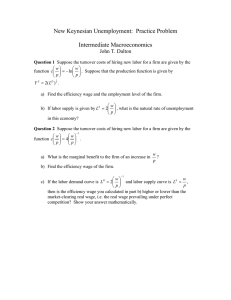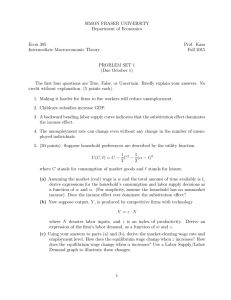
23/03/2022 Macroeconomics • The macro section will be broken up into 5 chapters: • Chapter 9, 10, 13, 14 and 15 • First we begin by understand the “Aggregate supply” side of the market which is all about inputs with a focus on labour. • Next we’ll begin to understand how money is created (Chapter 10). This is important to understanding “monetary policy” (Chapter 15). • Then we begin building a model for explaining how the economy behaves by talking about the AS/AD model. • Finally, we then talk about the role of the government and it’s intervention a la Monetary and fiscal policy (Chapter 14 and chapter 15) and its interaction with the AS/AD model. • This would give you a taste of macroeconomics . So let’s start! • We will conclude with chapter 17 to relate it back to some history. 1 THE LABOUR MARKET: WAGES, PROFITS, AND UNEMPLOYMENT (SECTION 9.1‐9.7, 9.9 AND 9.11) 2 1 23/03/2022 OUTLINE A. Introduction B. Measuring unemployment C. Price‐setting and wage‐setting D. Labour market equilibrium E. Labour market policies 3 A. Introduction 4 2 23/03/2022 This Unit • Models price‐setting and wage‐setting behaviour of firms, which determines economy‐wide unemployment rate and real wage • Explains why unemployment exists even in equilibrium • Shows how the government can affect wages and unemployment by its policies 5 B. Measuring unemployment 6 3 23/03/2022 The unemployed The unemployed are the people who: • are not in paid employment or self‐employment • are available for work • are actively seeking work 7 The labour market 8 4 23/03/2022 Labour market statistics Two countries with the same unemployment rate can differ in their employment rates if one has a high participation rate and the other has a low one. The structure of the labour market differs widely across countries. 9 C. Price‐setting and wage‐setting 10 5 23/03/2022 Price‐setting and wage‐setting • Firms and employees: firms set wage sufficiently high to make job loss costly, in order to motivate employees to work hard in the absence of complete contracts • Firms and customers: firms set a markup above the cost of production, to maximise their profits subject to demand. 11 The real wage The real wage is the nominal wage divided by the price level of the bundle of consumer goods purchased. 1. each firm decides on its: price, wage, how many people to hire 2. adding up all of these across all firms gives the total employment in the economy and the real wage 12 6 23/03/2022 The chain of firm’s decisions Nominal wage = f(other firms’ prices and wages, unemployment rate) Price = f(own nominal wage, demand for own product) Output = f(optimal price, demand curve) Number of employees = f(output, production function) 13 The wage‐setting curve The wage‐setting curve = the real wage necessary at each level of economy‐wide employment to provide workers with incentives to work hard and well. If the employment rate is X, then the equilibrium wage will be Y. 14 7 23/03/2022 Deriving the wage‐setting curve • Start with the labour discipline model (unit 6) • Lowering the unemployment rate will shift worker’s best response curve to the right (reservation wage↑) and increase wage • This results in upward‐ sloping wage‐setting curve 15 An estimated wage curve • Estimated from US data • Uses data on unemployment rates and wages in local areas 16 8 23/03/2022 The chain of firm’s decisions Nominal wage = f(other firms’ prices and wages, unemployment rate) Price = f(own nominal wage, demand for own product) Output = f(optimal price, demand curve) Number of employees = f(output, production function) 17 Profit‐maximizing price Firm’s optimal price lies where the demand curve is tangent to an isoprofit curve (unit 7). The firm then hires a number of employees necessary to produce the quantity of output demanded at that price. 18 9 23/03/2022 Distribution of output The firm’s choice of profit‐maximizing price also determines the firm’s optimal markup above the marginal cost of production. For the economy as a whole, this translates into how output is distributed between the firm‐owners and the workers. 19 The chain of firm’s decisions Nominal wage = f(other firms’ prices and wages, unemployment rate) Price = f(own nominal wage, demand for own product) Output = f(optimal price, demand curve) Number of employees = f(output, production function) 20 10 23/03/2022 Deriving the price‐setting curve Once firms set their prices, this determines the level of output and markup in the economy. This then pins down the real wage. 21 The price‐setting curve The price‐setting curve = the real wage paid when firms choose their profit‐maximizing price. It depends on: • competition, which determines markup • labour productivity, which determines real wage for given markup 22 11 23/03/2022 D. Labour market equilibrium 23 The labour market equilibrium The wage‐setting and price‐ setting curves are two sides of the economy. The Nash equilibrium of the labour market is where the wage‐ and price‐setting curves intersect. 24 12 23/03/2022 The labour market equilibrium All parties are doing the best they can, given what everyone else is doing: • The firms are offering the least wage to ensure workers’ effort • Employment is the highest it can be, given the wage • Those who have jobs cannot improve their situation by asking for higher pay or working less hard • Those who do not have jobs would like to work, but cannot persuade firms to hire them by accepting lower wage (labour discipline concerns) 25 Involuntary unemployment Unemployment = excess supply in the labour market There will always be unemployment in labour market equilibrium But why? • No unemployment → zero cost of job loss → no effort • Therefore some unemployment is necessary to motivate workers • These are the involuntarily unemployed 26 13 23/03/2022 Involuntary unemployment • Why will there always be some involuntary unemployment in labour market equilibrium? • • • • If there was no unemployment: The cost of job loss is zero (no employment rent) because a worker who loses her job can immediately get another one at the same pay. Therefore some unemployment is necessary: It means the employer can motivate workers to provide effort on the job. Therefore the wage‐setting curve is always to the left of the labour supply curve. It follows that in any equilibrium, where the wage and price‐setting curves intersect, there must be unemployed people: This is shown by the gap between the wage‐setting curve and the labour supply curve. 27 Unemployment and aggregate demand The firm’s demand for labour depends on the demand for their goods and services (derived demand for labour). Aggregate demand = sum of the demand for all of the goods and services produced in the economy. The increase in unemployment caused by the fall in aggregate demand is called demand‐deficient unemployment. 28 14 23/03/2022 Demand‐deficient unemployment Low aggregate demand moves the economy from labour market equilibrium (X) to point B. B is not a Nash equilibrium: • Firms could lower wages • Lower costs → lower prices • Increase output and employment 29 Automatic adjustment Point B is not a Nash equilibrium: • Firms could lower wages without lowering workers’ effort • Lower wages allow them to cut their prices • Lower prices s mulate demand → output rises • Firms hire more workers to produce more … unemployment falls back to X 30 15 23/03/2022 Adjustment process • The wage is cut to the lower level by HR, and given the lower costs, the firms cuts the price to maximize profit. Firms would move to the right along their demand curve. Output and employment increase. • To see where the firm’s price cutting will stop, think about the new isoprofit curves once the cost of hiring labour has declined. Remember that as the cost (C) has fallen, at every point on the isoprofit curve is now at a higher profit level than was the case prior to the decline in wages. • Importantly, it is also steeper than before. Recall that the slope of the isoprofit curve is (p − C)/q) so that for example, at point B (q*, p*) the slope of the isoprofit curve with the lower wage is steeper. 31 Automatic adjustment in practice Real economies do not function so smoothly: • Workers resist cuts to their nominal wage (lower morale, strikes) • Lower wages means people spend less → aggregate demand falls further • Falling prices across the economy may lead consumers to postpone their purchases in hope to get even better bargain later • Thus highlights the potential need for government intervention to get back to point b how? Expand demand! 32 16 23/03/2022 Government intervention The government could increase its own spending to expand aggregate demand. • monetary policy • fiscal policy At B, firms would find it optimal to produce more (and hire more workers) instead of reducing wages. 33 Labour supply The supply of labour is another important determinant of labour market equilibrium. An increase in labour supply shifts the wage‐setting curve downward: • greater pool of unemployed • higher employment rents • lower cost of effort 34 17 23/03/2022 E. Labour market policies 35 Labour market policies Shifts in the price‐setting curve: 1. Educa on & training: labour produc vity ↑ 2. Wage subsidy: Produc on costs and prices ↓ Shifts in the wage‐setting curve: 1. Lower unemployment benefit: reserva on wage ↓ Shifts in labour supply curve: 1. immigra on policies: labour supply ↑ 2. childcare provision: female labour par cipa on ↑ 36 18 23/03/2022 Summary 1. Behaviour of firms sets wages and employment in an economy • The wage‐setting curve tracks the combinations of wages and unemployment feasible with workers’ effort • The price‐setting curve determines the real wage corresponding to profit‐maximising price 2. There will always be involuntary unemployment • Incomplete contracts • Deficient demand 37 In the next unit • A closer look at financial markets: the banking system • How individuals choose borrowing, saving, and consumption • Banks: Firms that create money in the process of supplying credit 38 19




